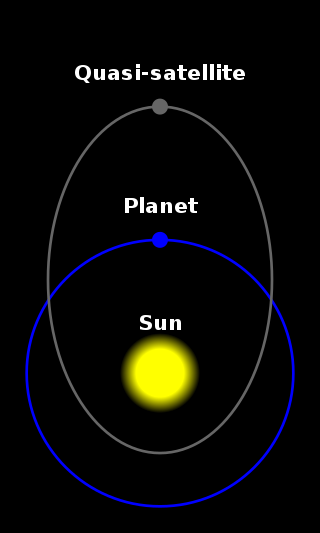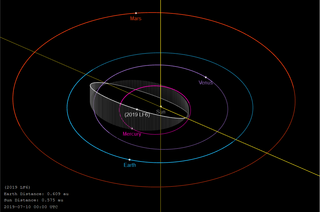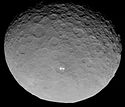Related Research Articles
2003 YN107 is a tiny asteroid, classified as a near-Earth object of the Aten group moving in a 1:1 mean-motion resonance with Earth. Because of that, it is in a co-orbital configuration relative to Earth.

A quasi-satellite is an object in a specific type of co-orbital configuration with a planet where the object stays close to that planet over many orbital periods.

In celestial mechanics, a horseshoe orbit is a type of co-orbital motion of a small orbiting body relative to a larger orbiting body. The osculating (instantaneous) orbital period of the smaller body remains very near that of the larger body, and if its orbit is a little more eccentric than that of the larger body, during every period it appears to trace an ellipse around a point on the larger object's orbit. However, the loop is not closed but drifts forward or backward so that the point it circles will appear to move smoothly along the larger body's orbit over a long period of time. When the object approaches the larger body closely at either end of its trajectory, its apparent direction changes. Over an entire cycle the center traces the outline of a horseshoe, with the larger body between the 'horns'.

(524522) 2002 VE68, provisional designation 2002 VE68, is a sub-kilometer sized asteroid and temporary quasi-satellite of Venus. It was the first such object to be discovered around a major planet in the Solar System. In a frame of reference rotating with Venus, it appears to travel around it during one Venerean year but it actually orbits the Sun, not Venus.

15810 Arawn, provisional designation 1994 JR1, is a trans-Neptunian object (TNO) from the inner regions of the Kuiper belt, approximately 133 kilometres (83 mi) in diameter. It belongs to the plutinos, the largest class of resonant TNOs. It was named after Arawn, the ruler of the underworld in Welsh mythology, and discovered on 12 May 1994, by astronomers Michael Irwin and Anna Żytkow with the 2.5-metre Isaac Newton Telescope at Roque de los Muchachos Observatory in the Canary Islands, Spain.

Asteroid 2011 QF99 is a minor planet from the outer Solar System and the first known Uranus trojan to be discovered. It measures approximately 60 kilometers (37 miles) in diameter, assuming an albedo of 0.05. It was first observed 29 August 2011 during a deep survey of trans-Neptunian objects conducted with the Canada–France–Hawaii Telescope, but its identification as Uranian trojan was not announced until 2013.
2013 BS45 (also written 2013 BS45) is a horseshoe companion to the Earth like 3753 Cruithne. Like Cruithne, it does not orbit the Earth in the normal sense and at times it is on the other side of the Sun, yet it still periodically comes nearer to the Earth in sort of halo orbit before again drifting away. While not a traditional natural satellite, it does not quite have normal heliocentric orbit either and these are sometimes called quasi-satellties or horseshoe orbits.
2013 ND15 (also written 2013 ND15) is an asteroid that is a temporary trojan of Venus, the first known Venus trojan.
2014 OL339 (also written 2014 OL339) is an Aten asteroid that is a temporary quasi-satellite of Earth, the fourth known Earth quasi-satellite.
2013 LX28, is an asteroid, classified as near-Earth object of the Apollo group that is a temporary quasi-satellite of the Earth, the third known Earth quasi-satellite.
2015 SO2 (also written 2015 SO2) is an Aten asteroid that is a temporary horseshoe companion to the Earth, the ninth known Earth horseshoe librator. Prior to its most recent close encounter with our planet (2015 September 30) it was an Apollo asteroid.

469219 Kamoʻoalewa, provisionally designated 2016 HO3, is a very small asteroid, fast rotator and near-Earth object of the Apollo group, approximately 40–100 meters (130–330 feet) in diameter. At present it is a quasi-satellite of Earth, and currently the second-smallest, closest, and most stable known such quasi-satellite (after 2023 FW13). The asteroid was discovered by Pan-STARRS at Haleakala Observatory on 27 April 2016. It was named Kamoʻoalewa, a Hawaiian word that refers to an oscillating celestial object. The Earth-like orbit and lunar-like silicates may be a result of it being lunar ejecta.
2014 YX49 is a centaur and Uranus co-orbital, approximately 77 kilometers (48 miles) in diameter, first observed on December 26, 2014, by the Pan-STARRS survey. It is the second known centaur on a tadpole orbit with Uranus, and the fourth Uranus co-orbital discovered after 83982 Crantor, 2011 QF99 and (472651) 2015 DB216.
2017 FZ2 (also written 2017 FZ2) is a micro-asteroid and near-Earth object of the Apollo group that was a quasi-satellite of the Earth until March 23, 2017.
A hyperbolic asteroid is any sort of asteroid or non-cometary astronomical object observed to have an orbit not bound to the Sun and will have an orbital eccentricity greater than 1 when near perihelion. Unlike hyperbolic comets, they have not been seen out-gassing light elements, and therefore have no cometary coma. Most of these objects will only be weakly hyperbolic and will not be of interstellar origin.
(457175) 2008 GO98, provisional designation 2008 GO98 with cometary number 362P, is a Jupiter family comet in a quasi-Hilda orbit within the outermost regions of the asteroid belt. It was discovered on 8 April 2008, by astronomers of the Spacewatch program at Kitt Peak National Observatory near Tucson, Arizona, in the United States. This presumably carbonaceous body has a diameter of approximately 15 kilometers (9 miles) and rotation period of 10.7 hours.
A temporary satellite is an object which has been captured by the gravitational field of a planet and thus has become the planet's natural satellite, but, unlike irregular moons of the larger outer planets of the Solar System, will eventually either leave its orbit around the planet or collide with the planet. The only observed examples are 2006 RH120, a temporary satellite of Earth for twelve months from July 2006 to July 2007, and 2020 CD3, which was discovered in 2020. Some defunct space probes or rockets have also been observed on temporary satellite orbits.

2019 LF6 is a near-Earth object of the Atira group. After 2021 PH27, it has the second-smallest semi-major axis among the known asteroids (0.555 AU), beating the previously-held record of 2019 AQ3. It orbits the Sun in 151 days.
2020 PN1 is a sub-kilometer asteroid, classified as a near-Earth object of the Aten group, that is a temporary horseshoe companion to the Earth. There are dozens of known Earth horseshoe librators, some of which switch periodically between the quasi-satellite and the horseshoe co-orbital states.
2020 PP1 is a sub-kilometer asteroid, classified as a near-Earth object of the Apollo group, that is a temporary quasi-satellite of the Earth. There are over a dozen known Earth quasi-satellites, some of which switch periodically between the quasi-satellite and horseshoe co-orbital states.
References
- 1 2 "(76146) = 2000 EU16 = 2002 TO288". Minor Planet Center. International Astronomical Union. Retrieved 13 December 2021.
- 1 2 3 "JPL Small-Body Database Browser: 76146 (2000 EU16)" (2021-10-22 last obs.). Jet Propulsion Laboratory . Retrieved 13 December 2021.
- ↑ The analemma criterion: accidental quasi-satellites are indeed true quasi-satellites C. de la Fuente Marcos & R. de la Fuente Marcos, Monthly Notices of the Royal Astronomical Society, Volume 462, Issue 3, 01 November 2016, Pages 3344–3349

